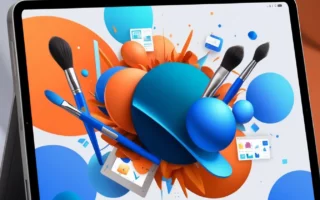Delving deep into the world of graphic design, we reveal the secrets and techniques that transform ideas into impactful visuals. We’ll cover every essential aspect of creating memorable artwork, from choosing colors to building a captivating visual narrative. This comprehensive guide is perfect for both beginners and seasoned professionals, providing valuable insights for those who want to master this art. Get ready to dive into the fascinating world of graphic design and discover how every detail can make a difference.
Graphic design is an art form that combines creativity and technique to communicate ideas in a visually appealing and effective way.
More than just aesthetics, graphic design has the power to influence perceptions, evoke emotions and convey complex messages in an accessible way.
Exploring the world of graphic design means understanding and mastering key elements such as color, typography, composition and visual narrative.
Each of these components contributes to creating designs that not only capture attention, but also communicate clearly and engagingly.
Let's explore together how these elements come together to form the basis of effective graphic design.
The Magic of Colors in Graphic Design
One of the most powerful aspects of exploring the world of graphic design is understanding color.
Colors have the ability to influence emotions and perceptions, making them a crucial tool for any designer.
Mastering color theory is essential to creating designs that effectively communicate your desired message.
Colors can be used to create contrasts, harmonies and highlight specific elements within a design.
For example, as you explore the world of graphic design, you will learn that complementary colors, when used together, create a strong visual impact, while analogous colors can create a sense of harmony and cohesion.
Another secret of graphic design is the psychology of colors. Each color carries meanings and emotional associations that can influence how the public perceives a brand or message.
Red, for example, is often associated with passion or danger, while blue evokes feelings of calm and confidence.
Knowing how to apply these principles when exploring the world of graphic design will allow you to create designs that resonate with your audience in a profound way.
Additionally, color saturation and brightness play important roles in creating a balanced visual composition.
Vibrant colors can convey energy and dynamism, while softer, desaturated tones create a sense of serenity.
Understanding these nuances when exploring the world of graphic design is essential to creating visually impactful works of art.
Typography: The Fundamentals of Graphic Design
Typography is one of the pillars when exploring the world of graphic design.
Font choices can transform the way a message is perceived, and the right typography reinforces the tone and purpose of a design.
To master the art of graphic design, it is essential to understand how to use typography effectively.
Serif fonts, such as Times New Roman, are ideal for conveying a sense of tradition and seriousness.
Sans-serif fonts, like Helvetica, offer a more modern, clean look, perfect for minimalist designs.
As you explore the world of graphic design, you will realize that choosing typography is one of the most important elements in building a cohesive visual identity.
In addition to font selection, typographic hierarchy is crucial. This principle organizes content so that the most important information stands out, guiding the reader through the design.
One of the secrets to exploring the world of graphic design is knowing how to use font size, weight and spacing to create a clear and effective hierarchy.
Another vital aspect is spacing, both between letters (kerning) and between lines (leading). Precise adjustments to these details ensure that the text is not only legible, but also aesthetically pleasing.
As you explore the world of graphic design, you'll learn that these small tweaks can make a big difference in the overall impact of your design.
Finally, combining different fonts can add dynamism to a design, but should be done with caution.
Consistency is key to ensuring your design remains cohesive and clear.
As you explore the world of graphic design, you will discover how to balance creativity with functionality when choosing and combining fonts.
Composition: The Art of Visual Balance
Composition is where all the visual elements come together to create a cohesive and effective design.
When exploring the world of graphic design, it is crucial to understand how to balance colors, typography, images and space to create a balanced and visually pleasing composition.
One of the basic principles of composition is the rule of thirds, which divides the design into nine equal parts, with the intersection points serving as the main focal points.
This technique is one of the secrets when exploring the world of graphic design, helping to create a balanced and aesthetically pleasing arrangement of elements.
Negative space, or white space, also plays a crucial role in composition.
Often underestimated, negative space is a powerful tool that can highlight important elements and create a cleaner, easier-to-interpret design.
As you explore the world of graphic design, you will learn the importance of letting elements “breathe” to avoid an overloaded look.
Additionally, repetition and alignment are techniques that help unify the design.
Repeating elements, such as colors or shapes, creates a sense of continuity, while correct alignment ensures that all elements are arranged logically.
These principles are fundamental when exploring the world of graphic design and are essential for creating harmonious designs.
Symmetry and asymmetry are also important tools in composition.
While symmetry offers a sense of balance and stability, asymmetry can bring dynamism and interest to a design.
Knowing when and how to use each of these approaches is one of the secrets when exploring the world of graphic design.
Visual Storytelling: Telling Stories through Graphic Design
One of the most fascinating aspects of exploring the world of graphic design is the ability to tell visual stories.
Visual storytelling allows designers to communicate complex messages in a simple and captivating way, creating an emotional connection with their audience.
Visual storytelling starts with choosing the right images. These images should not only be aesthetically pleasing, but they should also reinforce and complement the text and message you want to convey.
As you explore the world of graphic design, you'll realize that careful image selection is key to creating a cohesive visual narrative.
The sequence of images is equally important. Just as a good story has a natural flow, well-executed graphic design guides the viewer through the visual elements in a logical and engaging way.
One of the secrets to exploring the world of graphic design is knowing how to organize images in a way that creates a lasting impact.
The integration of text and image is also crucial in visual storytelling. Text and image must work together to reinforce the message and create a harmonious visual experience.
As you explore the world of graphic design, you'll learn how to balance these elements to maximize the impact of your storytelling.
Ultimately, visual storytelling can be applied to projects of any scale, from small posters to complex advertising campaigns.
As you explore the world of graphic design, you will discover that, regardless of the size of the project, a well-constructed narrative can transform a design into a powerful communication tool.
Innovation and Evolution in Graphic Design
Exploring the world of graphic design also means being in tune with the trends and innovations that shape the industry.
Graphic design is a field that is constantly evolving, and keeping up with the latest developments is essential to staying relevant and competitive.
One of the emerging trends when exploring the world of graphic design is the use of gradients and vibrant colors.
These elements bring a sense of modernity and depth to designs, making them more dynamic and attractive.
Integrating these trends into your work is a way to innovate and stay ahead of the curve.
Additionally, minimalism continues to be a popular approach. Focusing on simplicity and clarity allows the design to communicate the message directly and effectively.
However, as you explore the world of graphic design, you'll realize that the real challenge of minimalism is balancing simplicity with visual depth.
Another area of innovation is experimental typography, where fonts are used in new and creative ways to add a touch of originality to a design.
As you explore the world of graphic design, you'll be able to experiment with different typographic styles to create something truly unique.
Finally, sustainability has become a growing concern in graphic design.
Using environmentally friendly materials and practices not only meets market demands, but also reflects an increasingly valued social conscience.
By exploring the world of graphic design, you can find ways to incorporate sustainable practices into your work, creating designs that are both visually appealing and environmentally responsible.
Conclusion
Exploring the world of graphic design is an exciting and rewarding journey.
By mastering essential elements like color, typography, composition, and visual storytelling, you'll be able to create designs that not only capture attention, but also communicate clearly and engagingly.
As you continue to explore the world of graphic design, remember that innovation and adaptation are essential for continued growth.
Stay up to date with the latest trends and always be willing to try new ideas and approaches.
With dedication, practice, and an open mind, you'll be on your way to becoming a master graphic designer, capable of creating works that leave a lasting impression.



